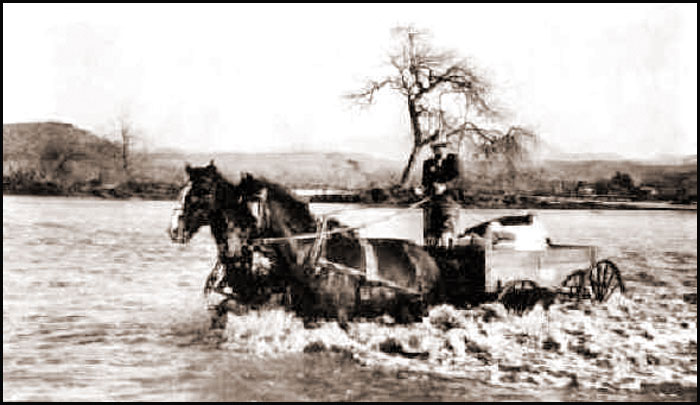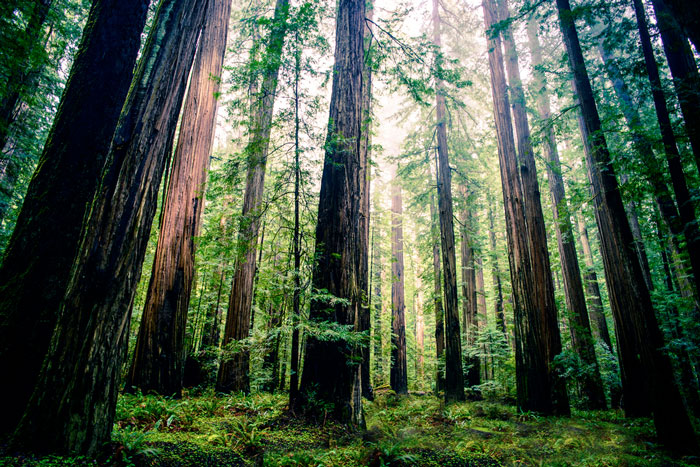Hacienda, Russian River, Sonoma, California
Dirt

The green area is the watershed for Russian River.
All the best stories start with dirt. Just consider Adam and Eve. In this story, the dirt of the Pacific plate is ramming the dirt of the North American plate creating the San Andreas fault line. The Pacific plate is causing wrinkles in the North American plate known as the coastal mountains, and water running through the resulting valleys makes rivers. The rivers wiggle though the mountains to get to the ocean. Were it not for what we call the Cotati Ridge (derived from the Kota’ti, a peaceful tribe-let of the Coast Miwok,) this river would probably join up with the Petaluma River and dump into the San Francisco Bay. But the ridge is 113 feet high and divides the watersheds of Russian River and The Bay.
So this situation, water flowing day and night through the coastal mountains, went on for about 30 million or so years. No natural barriers like the Cotati Ridge got in the way of making a path through the costal range, and it improved the path as it deemed necessary. The river has a tendency to flood every 20 years and that made even more opportunities to refine its pathway. That would be 1.5 million floods. One of the first challenges the river met in the costal range was Black Mountain. (A second Black Mountain is located closer to the coast.) The unimaginatively named mountain has been pounded by the current for millennia. The lighter debris and soil was pushed out of the way and was deposited on the shore opposite the channel: we call that deposit Mom's Beach. The small rocks were carried downstream to where the water movement slowed. There the rocks were dropped, deposited in multiple layers over time creating a gravel bar. We call that gravel bar Hacienda Beach.

This action also carried smaller rocks a bit further downstream creating a shallow section of the river just beyond the gravel bar. This section of the river became one of the few places the river is so shallow that it can be easily crossed in summer. Riders on horses and wagons could go through the shallow river to get to the other side. The wagons would sit in the river, cooling down their axles, wetting down the wooden wheels to prevent spitting . The horses would drink. The humans would sit and stare in awe at the beauty.

An example of fording a river when there is no bridge. This is not Russian River.
What the humans saw that was so staggering to the mind were redwood trees, perhaps the most beautiful and inspiring trees in the world.
John Steinbeck wrote, "The redwoods, once seen, leave a mark or create a vision that stays with you always. No one has ever successfully painted or photographed a redwood tree. The feeling they produce is not transferable. From them comes silence and awe. It's not only their unbelievable stature, nor the color which seems to shift and vary under your eyes, no, they are not like any trees we know, they are ambassadors from another time."

The three redwood subfamily genera are Sequoia and Sequoiadendron of California and Oregon, United States; and Metasequoia in China. Only two of the genera, Sequoia and Sequoiadendron, are known for massive trees. Redwood trees grow 300 feet tall and live for thousands of years making them the true living inhabitants of the river valley. Everything else only visits. If the trees do see us, we are nothing but ghostly blurred images. Unfortunately, the redwood is on the endangered species list. The small environmental area that supports their growth in California is getting warmer and dryer.
We call our wiggling river the "Russian River." The river was originally known among the Southern Pomo as Ashokawna (ʼaš:oʼkʰawna), "east water place" or "water to the east," and as Bidapte, "big river."
In 1827 the Spanish called it the San Ygnacio, and in 1843 the Spanish land grant referred to it as Rio Grande. The Pomo were better namers.
The river takes its current name from Ivan Kuskov of the Russian-American Company, who explored the river in the early 19th century and established the Fort Ross colony 10 mi (16 km) northwest of its mouth. The Russians called it the Slavyanka (Славянка), meaning "Slav River".
The Russian River makes its way from the north mostly without drama until it reaches the redwoods. The river enters the redwood forest around Mirabel Park, about five miles upstream from Hacienda. Mirabel Park is part of the Hacienda story, as is Hilton and Korbel.
Humans are just a blip against the river and the redwoods. But we shall consider the humans as well. We start the human part of the story in 1852.